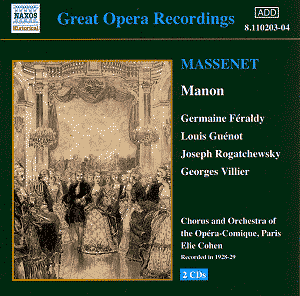This
classic of the gramophone – an oft-used phrase but used without
equivocation here – returns to the catalogue in a transfer overseen
by Ward Marston. It’s been around recently of course – I last
saw it on EPM – but there seem to be no rivals at the moment so
we should savour the judicious timing. One small point before
we go any further – Marston has applied some artificial reverberation
to attempt to counter the rather dead acoustic of the Columbia
studios in Paris. It’s not something I’m particularly keen on
but it has been applied with a degree of discretion here; those
who object should be advised to seek out alternative transfers.
The
first Manon predates this one by a number of years. Henri Busser
took a stellar cast into the studios in 1923 to record for Pathé
Hill and Dale. The trump cards were Fanny Heldy – delicious –
and Jean Marny who made an imposing presence. Those lucky enough
to have heard it will have doubtless have admired it, even at
Busser’s fizzing tempi and it can be found, surprise, surprise,
on Ward Marston’s own eponymous label. Elie Cohen’s Manon was
recorded between December 1928 and March 1929 and this entailed
some cast shuffling; a look at the head note will reveal that
there are three Rosettes, two De Brétignys and two Javottes.
The consistency maintained throughout the recording however more
than compensates for the exigencies of programming entailed by
a drawn out schedule. Foremost among them is Germaine Féraldy,
who falls securely into the light voiced Franco-Belgian tradition
(as indeed had Heldy before her). Her emotive presence is unmissable;
her impersonation is uncannily convincing whether pouting or lolling
in soubrettish delight or singing the love music with such elegance
and authentic panache. With her is Josef Rogatchewsky, Russian
born but who carved out a distinguished career in France. He’s
rather less aristocratic than Marny before him but he does possess
a beautifully equalized tone and a powerful instinct for the emotive
subtext. In addition he has a sure command of expressive diminuendi
and pianissimi, which lend subtlety and depth to his musicianship.
Leading
them is Elie Cohen. He makes some theatre cuts – expected at this
time in the recording industry – and does away with some of the
bridging passages but otherwise he is an excellent conductor;
firm, flexible, certainly no dawdler because this is a noticeably
taut and quick moving Manon. Listen to the springy string playing
he encourages in the Prelude – real light, French bowing – and
the fine chattering oboes as well. There is some overload in Hors
d’oeuvre de choix- a passage where the added reverberation
is too much for me – and a little distortion as well (Marston
goes into the ramifications of the recording problems, not that
there were many, in some detail). Elsewhere one can appreciate
Féraldy’s exquisite portamenti in Je suis encore tout
étourdie as well as what one has to call her provocatively
fluttery elegance in her scene with Des Grieux (Quelqu’un…J’ai
marqué) and her delicately shaded lower notes. Rogatchewsky
shines in this scene as well – where his strength and ardency
and sheer stylishness make themselves wonderfully apparent.
For
balance between orchestra and singers try Act II’s C’est lui!
where the delicate orchestral choirs behind Rogatchewsky are perfectly
judged by both conductor and recording engineers. And in the Third
Act Entr’acte we can hear more of those gut string fiddle players
and the perky bass – there’s a real idiomatic crispness to their
phrasing here and throughout. Admirers of this kind of patina
should listen long and hard to the Gallic charm of the solo violin
in Ballet…C’est fête in Act III or indeed to the
violins’ portamanti in Les Dévotes’ Quelle éloquence
(a sentiment I’m happy to second). One can hear in this playing
remnants of the Capet tradition in French violin playing as well
as the expected eloquence of the violas and cellos. The other
vocal parts are splendidly taken as well; Georges Villier and
Louis Guénot make a formidable pairing.
I’m
sufficiently concerned about the artificial reverberation to withhold
absolute recommendation. Of the performance itself I have no doubts.
This is the French tradition caught still in its heyday and it
has given us a Manon in some ways still unmatched.
Jonathan
Woolf
see
also review by Richard
Lee-Van den Daele
